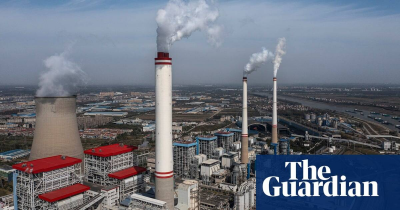The Guardian - China-Chinas coal addiction puts spotlight on its climate ambitions before Cop28
November 27, 2023 4 min 812 words
这篇报道揭示了中国在气候承诺和能源安全之间的尖锐矛盾。虽然中国在气候峰会上承诺2030年前达到二氧化碳排放峰值,但实际上,地方政府在2023年上半年批准了50.4GW的新煤电项目。这显示出在能源短缺压力下,中国对煤电的过度依赖正在加深。2021年的能源危机导致严重停电,这让中国政府对能源安全的强调与减少对煤电的依赖目标发生直接冲突。 专家指出,提高电网技术基础设施,而非建设新的高污染发电机,是确保中国能源安全的关键。绿色和可再生能源的储能技术可以在整个能源转型中发挥主导作用。然而,地方政府更关注保障电力供应,将煤电视为安全底线。此外,中国政府最近发布的煤电容量补偿机制可能鼓励更多的煤电建设,加深了人们对中国在能源转型上的担忧。 尽管中国的太阳能容量已超过全球总和,但煤炭仍占据其总能源消耗的一半以上。中国应认真审视并平衡气候目标和能源安全之间的关系,采取可持续的能源策略,以维护全球气候责任。
China’s addiction to building new coal-fired power plants is becoming increasingly entrenched, even as the country is on track to reach peak CO2 emissions before its 2030 target.
As climate officials from around the world prepare to meet in the United Arab Emirates for Cop28, many are hoping that the recent joint climate agreement between the US and China, released days before Joe Biden and Xi Jinping met in California, can lay the groundwork for positive commitments at the UN’s climate conference.
The last major breakthrough involving China at Cop was at Cop26 in Glasgow, in 2021. At that conference, China pledged CO2 emissions would peak by 2030. Xi said that China would “strictly control coal-fired power generation projects”.
But 2021 was also the year in which severe power outages blighted many parts of China, leading to rationing, closed factories and cold homes as local authorities struggled to cope with sudden shortages of energy.
In 2022, further energy crunches in south-west China underlined the importance of stable energy supplies to Chinese officials. That has put the commitment to reduce reliance on coal-fired energy in direct tension with the new emphasis on energy security.
“Chinese officials view coal as the primary guarantee of energy security,” said Anders Hove, senior research fellow at the Oxford Institute for Energy Studies. “For this reason, it is now considered sensitive to criticise the country’s present investments in coal.”
Local governments in China approved 50.4GW of new coal power in the first half of 2023. And in 2022, construction started on 50GW of coal capacity, an amount six times as large as the rest of the world combined.
Despite growing demand for energy, China still has far more coal power capacity than it needs. Last year the average utilisation rate for coal power plants was just over 50%.
Experts say that the way to ensure China’s energy security is to improve the technological infrastructure of the grid to make it more stable and efficient, not build new dirty generators.
“Energy storage is the key for China’s energy transition,” said Gao Yuhe, a senior campaigner at Greenpeace East Asia. Energy storage can enable “renewable energy to take a leading role in the whole energy transition”.
Coal power plants take a long time to power up and cool down, meaning that they are relatively inflexible. Renewable energy storage enables the grid to overcome the challenge created by the fact that most of China’s renewable energy is generated in the west of the country, while most of the energy consumption happens in the east.
Getting the energy to the right place at the right time is one of the biggest challenges facing China’s energy transition. Local government officials, who are more concerned with keeping the lights on than with green targets, see coal as a safety net.
During last year’s power crunch in Sichuan, a heatwave raised the demand for energy as people turned on air-conditioning units. At the same time, a drought meant that there was much less hydropower energy generation.
“Sichuan suddenly couldn’t meet their electricity export obligations and meet local demand,” said Lauri Myllyvirta, lead analyst for the Centre for Research on Energy and Clean Air. A rigid energy planning system meant that Sichuan continued to export energy, even when it created local blackouts.
“Local governments do not want to phase out coal as soon as possible,” said Gao, adding that the central government’s emphasis on energy security empowers local officials further to permit new coal.
Hua Wen, a China project director at the Natural Resources Defence Council, notes that the top five provinces that have approved the most new coal power since 2021 “are China’s industrial powerhouses and net electricity importers. These provinces are seeking to reduce their reliance on imported electricity to meet their increasing electricity demand [and] to prevent or reduce the risk of future power shortages”.
Wen added that some smaller and more inefficient coal power plants have been closed in recent years, partially offsetting the surge in new approvals.
Recent policy developments suggest that China is doubling down on coal, even as the rapid construction of green energy infrastructure means that the average annual increase in China’s energy demands can be serviced entirely by low-carbon energy. China’s solar capacity now exceeds the rest of the world combined, but coal still accounts for more than half of total energy consumption.
In November, the Chinese government released a long-awaited coal capacity compensation mechanism. The policy, which comes into effect on 1 January, guarantees payments to coal-fired power producers based on their installed capacity. This could incentivise the building of more coal, according to Hove. Other analysts say that the policy will allow more renewables to enter the energy mix without compromising stability.

